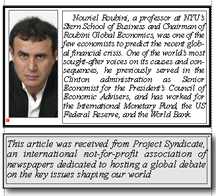By Nouriel Roubini
NEW YORK – Today’s fragile global economy faces many risks: the risk of another flare-up of the eurozone crisis; the risk of a worse-than-expected slowdown in China; and the risk that economic recovery in the United States will fizzle (yet again). But no risk is more serious than that posed by a further spike in oil prices.
 The price of a barrel of Brent crude, which was well below $100 in 2011, recently peaked at $125. Gasoline prices in the US are approaching $4 a gallon, a damaging threshold for consumer confidence, and will increase further during the high-demand summer season.
The price of a barrel of Brent crude, which was well below $100 in 2011, recently peaked at $125. Gasoline prices in the US are approaching $4 a gallon, a damaging threshold for consumer confidence, and will increase further during the high-demand summer season.
The reason is fear. Not only are oil supplies plentiful, but demand in the US and Europe has been lower, owing to decreasing car use in the last few years and weak or negative GDP growth in the US and the eurozone. Simply put, increasing worry about a military conflict between Israel and Iran has created a “fear premium.”
The last three global recessions (prior to 2008) were each caused by a geopolitical shock in the Middle East that led to a sharp spike in oil prices. The 1973 Yom Kippur War between Israel and the Arab states led to global stagflation (recession and inflation) in 1974-1975. The Iranian revolution in 1979 led to global stagflation in 1980-1982. And Iraq’s invasion of Kuwait in the summer of 1990 led to the global recession of 1990-1991.
Even the recent global recession, though triggered by a financial crisis, was exacerbated by spiking oil prices in 2008. With the barrel price reaching $145 in July of that year, oil-importing advanced economies and emerging markets alike faced a recessionary tipping point.
The risk that Israel’s threat to attack Iran’s nuclear installations will, in fact, lead to an outright military conflict may still be low, but it is growing. Israeli Prime Minister Binyamin Netanyahu’s recent visit to the US demonstrated that Israel’s fuse is much shorter than the Americans’. The current war of words is escalating, as is the covert war that Israel and the US are allegedly engaging in with Iran (including killings of nuclear scientists and use of cyber-warfare to damage nuclear facilities).
Iran, with its back to the wall as sanctions bite harder (especially the recent SWIFT and central bank restrictions, and Europe’s decision to stop importing Iranian oil), could react by increasing tensions in the Gulf. Eventually, it could easily sink a few ships to block the Strait of Hormuz, or unleash its proxies in the region, which include pro-Iranian Shia forces in Iraq, Bahrain, Kuwait, and Saudi Arabia, Hezbollah in Lebanon, and Hamas and Islamic Jihad in Gaza.
Recent attacks on Israeli embassies around the world appear to signal Iran’s reaction to the covert war being waged against it, and to the tightened sanctions, which are aggravating the effects of the regime’s economic mismanagement. Likewise, the recent escalation in cross-border fighting between Israel and Gaza-based Palestinian militants could be a sign of things to come.
The next few weeks could bring a reduction in tensions, as the US, France, Germany, the United Kingdom, China, and Russia go through another round of attempts to prevent Iran from developing nuclear weapons or the capacity to produce them. But if this attempt fails, as is likely, one cannot rule out that, by summer, Israel and the US agree that, sooner rather than later, force will have be used to stop Iran.
Indeed, while Israel and the US still disagree on some points – Israel wants to strike this year, while the Obama administration is opposed to military action before facing the voters in November – the two sides are converging on aims and plans. Most importantly, the US is now clearly rejecting containment (accepting a nuclear Iran and using a deterrence strategy). So, if sanctions and negotiations don’t credibly work, the US (a country that doesn’t “bluff,” according to Obama) will have to act militarily against Iran. The US is now providing bunker-buster bombs and refueling planes to Israel, while the two militaries are increasing joint military exercises in case an attack becomes necessary and unavoidable.
If the drums of war grow louder this summer, oil prices could rise in a way that will most likely cause a US and global growth slowdown, and even an outright recession if a military conflict erupts and sends oil prices soaring.
Moreover, broader geopolitical tensions in the Middle East are not fading, and might intensify. Aside from deep uncertainty regarding the course of events in Egypt and Libya, now Syria is on the verge of civil war, and radical forces may get the upper hand in Yemen, undermining security in Saudi Arabia. There is still concern about political tensions rising in Bahrain and Saudi Arabia’s oil-rich Eastern Province, and potentially even in Kuwait and Jordan, all areas with substantial Shia populations or other restless groups.
Now that the US has left Iraq, rising tensions between Shia, Sunni, and Kurdish factions do not bode well for the country’s ability to boost oil production soon. There is also the ongoing Israel-Palestine conflict, tension between Israel and Turkey, and hot spots – particularly Afghanistan and Pakistan – in the wider neighbourhood.
Oil is already well above $100/barrel, despite weak economic growth in advanced countries and many emerging markets. The fear premium might push prices significantly higher, even if no military conflict ultimately takes place, and could trigger a global recession if one does.




